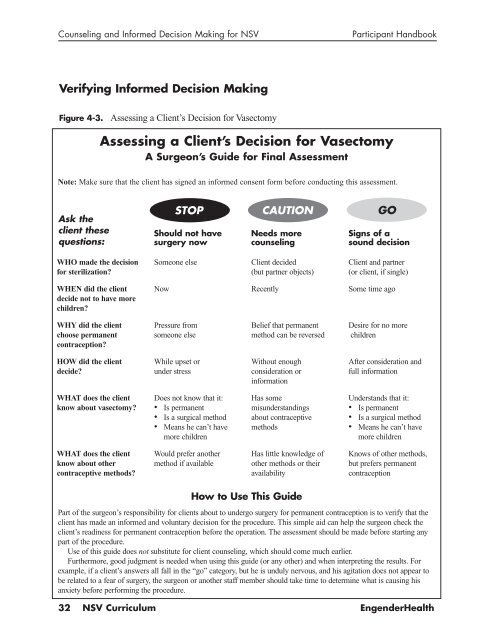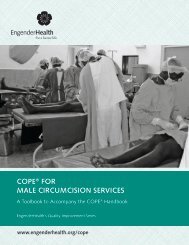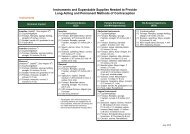NO-SCALPEL VASECTOMY - EngenderHealth
NO-SCALPEL VASECTOMY - EngenderHealth
NO-SCALPEL VASECTOMY - EngenderHealth
Create successful ePaper yourself
Turn your PDF publications into a flip-book with our unique Google optimized e-Paper software.
Counseling and Informed Decision Making for NSV Participant Handbook<br />
Verifying Informed Decision Making<br />
Figure 4-3. Assessing a Client’s Decision for Vasectomy<br />
WHO made the decision<br />
for sterilization?<br />
WHEN did the client<br />
decide not to have more<br />
children?<br />
WHY did the client<br />
choose permanent<br />
contraception?<br />
HOW did the client<br />
decide?<br />
WHAT does the client<br />
know about vasectomy?<br />
WHAT does the client<br />
know about other<br />
contraceptive methods?<br />
Assessing a Client’s Decision for Vasectomy<br />
A Surgeon’s Guide for Final Assessment<br />
Note: Make sure that the client has signed an informed consent form before conducting this assessment.<br />
Ask the<br />
client these<br />
questions:<br />
Someone else<br />
Now<br />
STOP CAUTION GO<br />
Should not have<br />
surgery now<br />
Pressure from<br />
someone else<br />
While upset or<br />
under stress<br />
Does not know that it:<br />
• Is permanent<br />
• Is a surgical method<br />
• Means he can’t have<br />
more children<br />
Would prefer another<br />
method if available<br />
Needs more<br />
counseling<br />
Client decided<br />
(but partner objects)<br />
Recently<br />
Belief that permanent<br />
method can be reversed<br />
Without enough<br />
consideration or<br />
information<br />
Has some<br />
misunderstandings<br />
about contraceptive<br />
methods<br />
Has little knowledge of<br />
other methods or their<br />
availability<br />
How to Use This Guide<br />
Signs of a<br />
sound decision<br />
Client and partner<br />
(or client, if single)<br />
Some time ago<br />
Desire for no more<br />
children<br />
After consideration and<br />
full information<br />
Understands that it:<br />
• Is permanent<br />
• Is a surgical method<br />
• Means he can’t have<br />
more children<br />
Knows of other methods,<br />
but prefers permanent<br />
contraception<br />
Part of the surgeon’s responsibility for clients about to undergo surgery for permanent contraception is to verify that the<br />
client has made an informed and voluntary decision for the procedure. This simple aid can help the surgeon check the<br />
client’s readiness for permanent contraception before the operation. The assessment should be made before starting any<br />
part of the procedure.<br />
Use of this guide does not substitute for client counseling, which should come much earlier.<br />
Furthermore, good judgment is needed when using this guide (or any other) and when interpreting the results. For<br />
example, if a client’s answers all fall in the “go” category, but he is unduly nervous, and his agitation does not appear to<br />
be related to a fear of surgery, the surgeon or another staff member should take time to determine what is causing his<br />
anxiety before performing the procedure.<br />
32 NSV Curriculum <strong>EngenderHealth</strong>

















